Case study of E-commerce : Amazon
23 Pages6627 Words392 Views
Added on 2021-05-25
Case study of E-commerce : Amazon
Added on 2021-05-25
ShareRelated Documents
Martin Luther Christian University Nongrah, Shillong, MeghalayaCase study of E-commerce On Submitted By,K.DawchaBBA 6th semester

Table of ContentsAbstract.................................................................................................11.BackgroundofEcommerce..............................................................22.ReviewofLiterature.......................................................................32.1ECommerceEvolution....................................................................................................32.2CaseStudy– Amazon ...................................................................................................... 52.2.1AmazonProgression.................................................................................................52.2.2Amazon'sCompetitor...............................................................................................72.2.3PESTELFrameworkAnalysis..................................................................................82.2.3.1Political..................................................................................................................82.2.3.2Environment........................................................................................................102.2.3.3Social...................................................................................................................112.2.3.4Technology..........................................................................................................112.2.3.5Economic.............................................................................................................132.2.3.6Legal....................................................................................................................143.ConclusionsandFutureTrend...............................................................................................153.1ConclusiononPESTELaffectingAmazon....................................................................153.2ChallengesofE-commerce............................................................................................163.3FutureTrend...................................................................................................................164.References.............................................................................................................................194.1ArticlesReferences........................................................
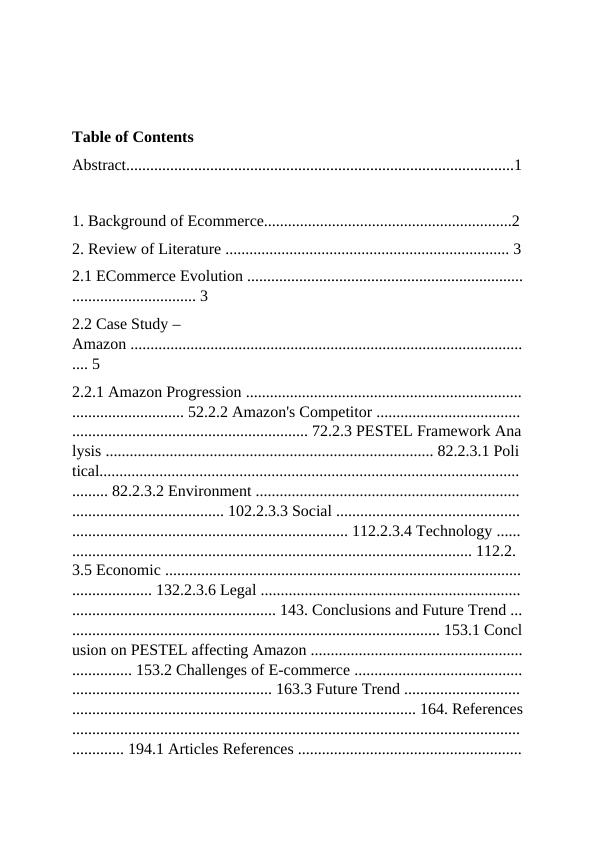
................................................194.2WebsiteReferences........................................................................................................20Table of FiguresFigure 1: Online Sales by Product Category................................................................................... 5Figure 2: Amazon Revenues Growth 2004-2015 ........................................................................... 6Figure 3: PESTEL Framework Analysis ........................................................................................ 8Figure 4: Forecast ofWorldwide Retail E-Commerce Sales........................................................ 17
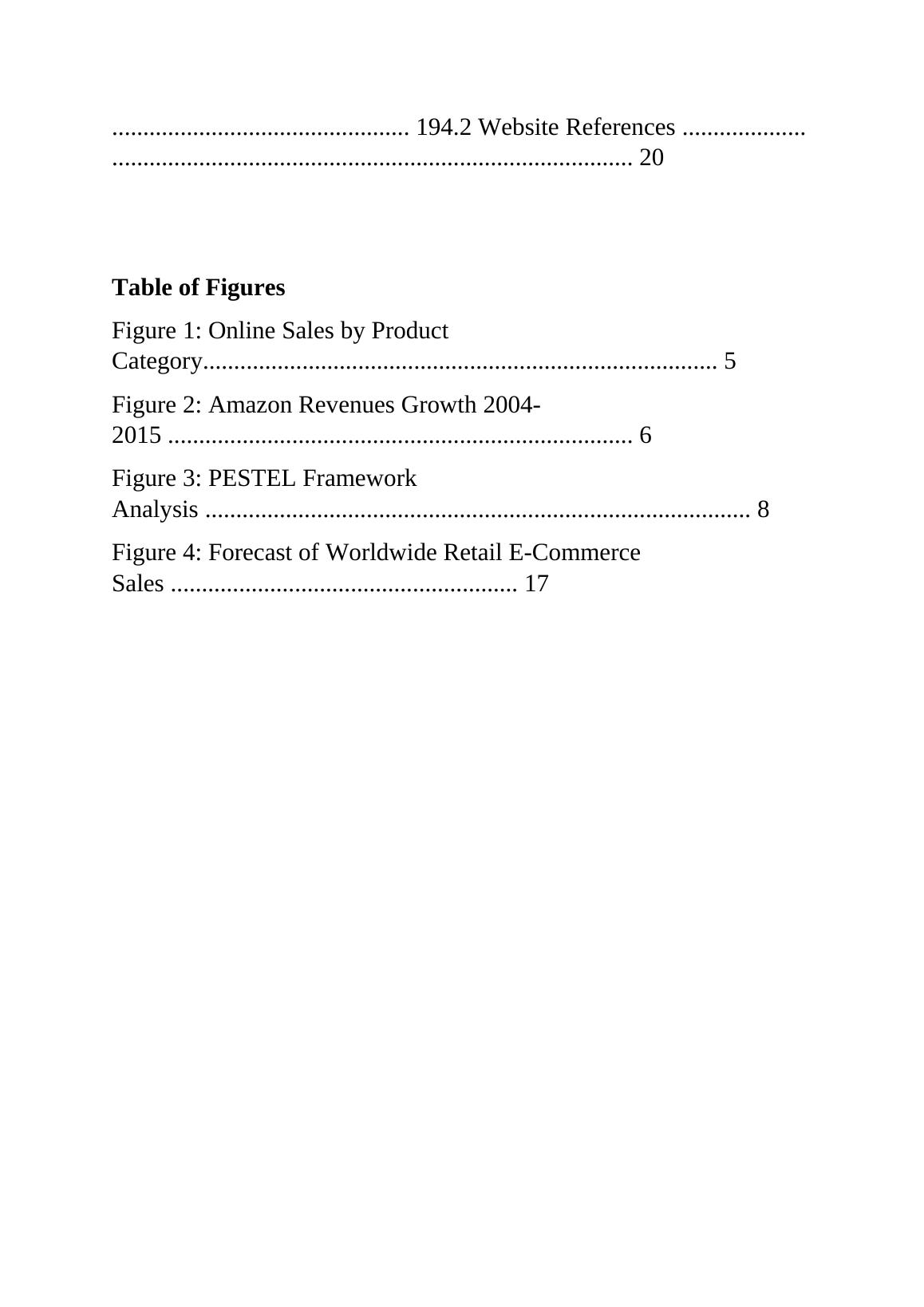
AbstractElectronic commerce or E-commerce allows consumers to electronically exchange goods and services with no barriers of time or distance. More customers moved from traditional purchase to e-commerce because it is often faster and cheaper. Besides, e-commerce offers more convenience and flexible for customization option of products and services.Amazon began as a small startup with a big vision and has revolutionized its present in e-commerce business over the past 20 years more than any other company. Amazon was chosen as a case study since it has changed the way people shop online with its e-commerce evolution overthe decades.In Amazon case study, like any other businesses regardless of traditional or online, are often affected by external factors. These factors are changing the way businesses operate and how the industry evolves. Political, Environment, Social, Technology, Economic and Legal (PESTEL)framework is a tool that is used to identify these external factors that affects the condition of abusiness organization or industry’s macro-environment.Amazon sells a great deal of consumer goods, the other main feature that puts the company onanother level is the multi-leveled e-commerce strategy it employs. It provides services to fourprimarycustomersets:consumers,sellers,enterprises,andcontentcreators.Thecompanyalsoprovidesothermarketingandpromotionalservices,suchasonlineadvertisingandco-brandedcredit card agreements.Selling goods isn't the only way the company makes money, its web site's affiliate program isone of the most famous on the Web. The level of integration that occurs on Amazon is aprogrammingfeatthatfew(if any) onlinesalessitescanmatch,Amazonmakeseverypossibleattempt to customizethe buyer experience. The massive technology core that keeps Amazon running is a major challenge, next to facing up growing competitors like Walmart, Alibaba,Google in the online business.
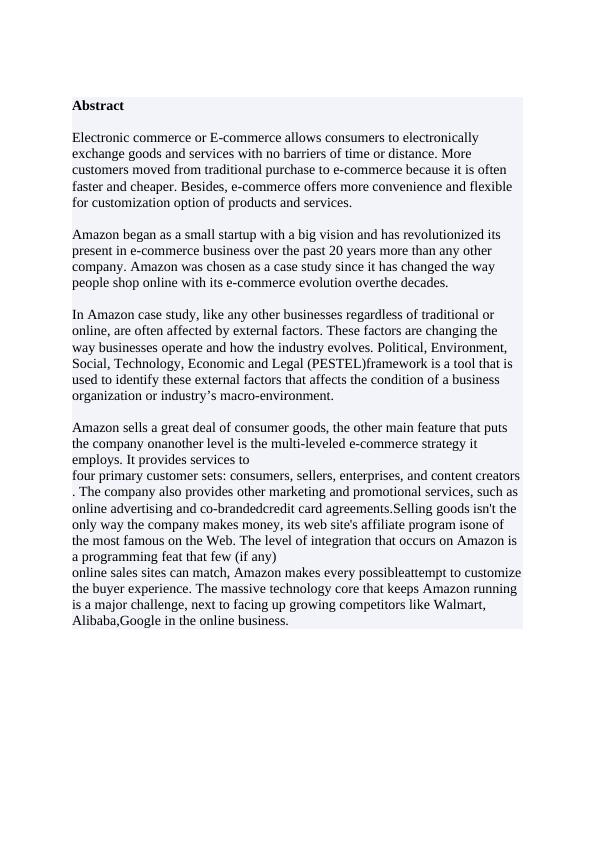
1.Background of E-CommerceIn e-commerce (electronic commerce) the trading business is done through the internet and it involves commercial transactions that include transfer of information. E-commerce simplymeans buying and selling products and services through the internet and is commonly associatedwith online shopping. It covers a range of different type of businesses, from consumer basedretail sites to business exchange trading goods andservices between corporations.There are four principal categories of e-commerce, namely B2B(Business to Business), B2C(Business to Consumer), C2B (Consumer to Business) and C2C (Consumer to Consumer). • B2B: Involves companies doing business with each other. One example ismanufacturers selling to distributors and wholesalers selling toretailers. • B2C: Comprises of businesses selling to the overall public through shopping cartsoftware, without needing any human interface. An example of this would beAmazon. • C2B: Consumers post a project with a set budget online, and companies bid on theproject.Theconsumerreviewsthebidsandselectsthecompany.Elanceisanexample of this. • C2C: Takes place within online classified ads, forums or marketplaces whereindividuals can buy and sell their goods. Examples of this include Craigslist, eBayand Etsy.Following the tech-savvy consumer demands, e-commerce has evolved over theyears as one ofthe main facets of the internet to emerge. Companies like Amazon began over a simple platformof B2C by merely selling goods and books and transformed to the biggest online retailer in theUnited States. Its operation is now serving multinational consumer markets including Europe,India and China. Nowadays the e-commerce giant provides a range of services ranging fromretail to cloud computing to book publishing. In year 2015, Amazon hit $107 billion revenue ascompare to $6.9 billion in year 2004.
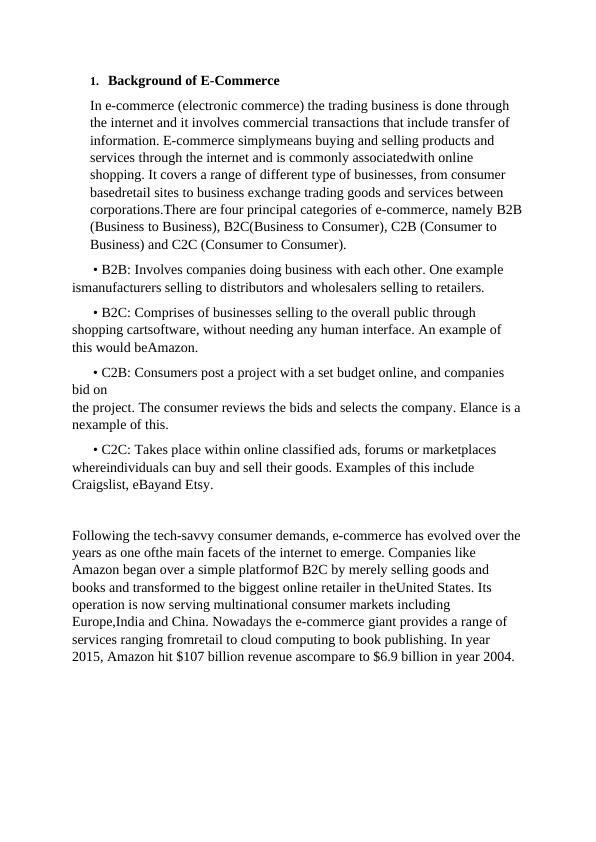
2.Review of Literature2.1E-Commerce EvolutionEarly development of e-commerce can be traced back to the 1960s, when companies started using Electronic Data Interchange (EDI) to share business documents with other companies. E-commerce was defined by IBM in 1972 when the first electronic transaction happened. As the number of individual users sharing electronic documents with each other grew in the 1980s, in the 1990s, the rise of eBay and Amazon transformed the e-commerce industry. The development of e-commerce has also led to rapid increase of internet sales as consumers begin to appreciatebenefits of:• Discounted price offered by sellers as they operate with less margin• Convenience to have a product delivered rather than the cost of time and transportand parking of going to a store• Sourcing low-priced product from overseas vendors• More variety of catalogue offered by onlinestores• Review engines that compare and recommend product• Uncommon goods sold for cheaper offer atauction sitesThe wide use of the internet globally has substantially contributed to the increase of online transactions. As mobile devices became more popular, mobile commerce has become its ownmarket. With the rise of sites like Facebook and Pinterest, social media has become an important driver of e-commerce. Source from Internet Live Stats (2015) showed that 201 countries around the world have internet access. The accessibility to internet help to grow E-commerce over thevirtual platform, below are the major milestones for the E-commerce evolution: 1979- Michael Aldrich is credited with inventing online shopping by connecting amodifieddomestic TV to a real-time transaction processing computer via adomestic telephone line. 1982- Minitel was introduced in France and was used for online ordering.1991–The World Wide Web is created
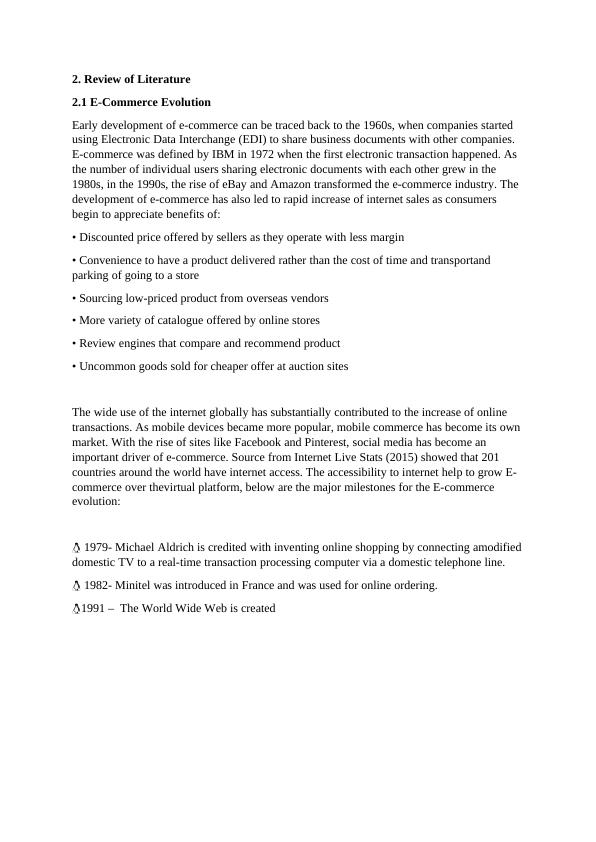
End of preview
Want to access all the pages? Upload your documents or become a member.
Related Documents
Online Supply Chain Management Approachlg...
|15
|3710
|490
Analysis of E-Commerce With Relevant Justificationlg...
|11
|3085
|23
Role of Electronic-Business and Commerce Research 2022lg...
|9
|1827
|18
Emerging Technology and Trend in e-Business: Assignmentlg...
|6
|1514
|304
E-Commerce Strategies and Technologieslg...
|11
|3273
|53
SBLC7015 International Business For Revenues And Marketlg...
|19
|4788
|69
